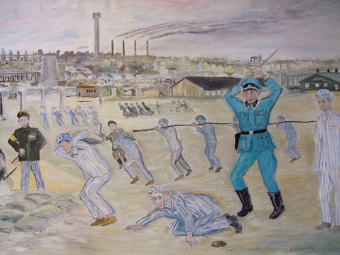Memories as Visual Images: Paintings by Former Prisoners

© Benjamin Grünfeld
In addition to written accounts of survival, some former prisoners also used other media to process their memories and depict the terrible conditions in a German concentration camp. Here we would like to introduce four painters who refer in different ways to the Buna/Monowitz concentration camp: former prisoners and artistic chroniclers of the concentration camps.
Benjamin Grünfeld, a Jew deported to the Buna/Monowitz concentration camp from Romania, began only many years after his liberation and emigration to Sweden to put the images in his memory onto canvas. The result was pastel-colored watercolors that constitute a memorial to the victims.
Serge Smulevic, deported to the Buna/Monowitz concentration camp from France in 1943, survived the camp in part because his drawings were appreciated by SS men. In 1947, after his liberation and return to France, he received an inquiry from the lead investigator of the Nuremberg Military Tribunal in the case against I.G. Farben, asking him to draw the occurrences in the Monowitz camp for use in the trial. These drawings depict essential scenes from camp life in a few strokes, against a colored background.
Thomas Geve (pseudonym), who was deported to Auschwitz as a 13-year-old and liberated in the Buchenwald concentration camp at the age of 15, drew his own recollections of procedures in the everyday life of the camp, as well as those related to him by fellow inmates, in the two months immediately after his liberation. Among these pictures is also a Buna/Monowitz camp map.
Maurice de la Pintière, right after his liberation from the Mittelbau-Dora concentration camp, to which many Monowitz inmates also were forced to go on the death march, drew scenes of what he had experienced and suffered. His pictures confine themselves to shades of gray, and they focus on the suffering of the slave laborers.
(SP; transl. KL)
















